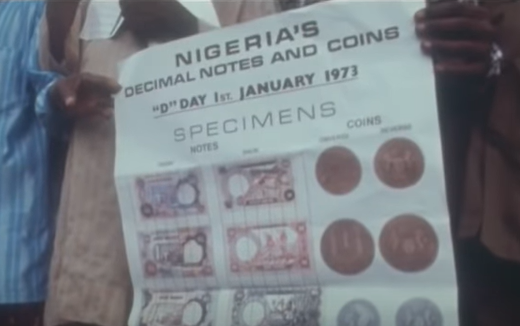Photo: Adeyinka Makinde/YouTube
On January 1, 1973, Nigeria birthed a new legal tender and its name was called naira.
Severing ties with the pounds, the country launched a new currency which would still hold five decades later.
The Nigerian naira, like other currencies, has evolved from ‘prime’ to ‘redesigning’.
The launch of the renamed currency followed the decision by the government to change from the metric to the decimal, according to the Central Bank of Nigeria (CBN).
Advertisement
The CBN said the decision was also borne out of a need to adopt a truly national currency and to replace the imperial system which was inherited from the British colonial administration.
BYE TO POUNDS AND SHILLINGS
The pounds and shillings were changed to naira and kobo and four denominations of notes were issued, comprising 50 kobo, N1, N5, and N10.
Advertisement
Consequently, the major unit of currency which used to be £1 ceased to exist and the N1 — which was equivalent to ten shillings — became the major unit.
Also, the minor unit was called the kobo — a hundred of which made N1.
NAIRA: COINED BY OBAFEMI AWOLOWO
According to a Punch report, the term ‘naira’ was coined by Obafemi Awolowo, during the military regime. Awolowo was the federal commissioner for finance (now called minister of finance) from 1967 to 1971.
Advertisement
Speaking in the interview, Tokunbo, one of Awolowo’s children, said: “He just took the name of Nigeria and collapsed it to naira. That’s what he told us and that was how he arrived at the name ‘naira’ and that was when he was the federal commissioner for finance.”
The naira was, however, introduced under the administration of Yakubu Gowon, Nigeria’s former head of state.
MORE BANKNOTES INTRODUCED
According to the CBN, N20 note was introduced on February 11, 1977, as the highest denomination at the time as a result of the growth of the economy, the preference for cash transactions, and the need for convenience.
Advertisement
The banknote was the first in Nigeria to bear the portrait of a prominent Nigerian citizen, Murtala Muhammed, former head of state.
“The note was issued on the first anniversary of his assassination as a fitting tribute to a most illustrious son of Nigeria,” the apex bank said.
Advertisement
The N50 note denomination was added in 1991.
Furthermore, in response to the expansion in economic activities and to facilitate an efficient payment system, the N100, N200, N500 and N1,000 banknotes were introduced in December 1999, November 2000, April 2001, and October 2005, respectively.
Advertisement
EVOLUTION OF NAIRA REDESIGN
On July 2, 1979, new currency banknotes of three denominations — N1, N5 and N10 — were introduced.
Advertisement
“These notes were of the same size i.e. 151 X 78 mm as the ₦20 note issued on 11th February, 1977,” CBN said.
“In order to facilitate identification, distinctive colours were used for the various denominations.”
In April 1984, the colours of all the banknotes in circulation were changed — with the exception of the 50 kobo banknote — to arrest the currency trafficking prevalent at the time.
In 1991, the 50 kobo and N1 were redesigned into coins.
On February 28, 2007, as part of the economic reforms, N20 was issued for the first time in polymer substrate, while the N50, N10 and N5 banknotes — as well as N1 and 50 kobo coins — were reissued in new designs, and the N2 coin was introduced.
On September 30, 2009 the redesigned N50, N10 and N5 banknotes were converted to polymer substrate following the successful performance of the N20 (polymer) banknote. Therefore, all lower denomination banknotes were now printed in the polymer substrate.
Afterwards, the CBN, as part of its contribution towards the celebration of the nation’s 50th anniversary of Nigeria’s Independence and 100 years of its existence as a nation, issued the N50 commemorative polymer banknote on September 29, 2010; and the N100 commemorative banknote on December 19, 2014, respectively.
50 YEARS LATER, THE NAIRA HAS A NEW DESIGN
On October 26, 2022, Godwin Emefiele, CBN governor, announced the plan to redesign the naira to control money supply and aid security agencies in tackling illicit financial flows.
On November 23, the new notes ‐- N200, N500 and N1000 — were launched.
Reaction to the currency redesign was not without backlash, while banks began to dispense the redesigned notes on December 15, 2022.
On December 8, Godwin Emefiele, CBN governor, said banks had received the new notes and “it would go round”, but TheCable had reported that some commercial banks had a limited supply of the new notes.
Add a comment






